Attached files
| file | filename |
|---|---|
| 8-K - 8-K - Hanesbrands Inc. | hbi-2017210x8k.htm |
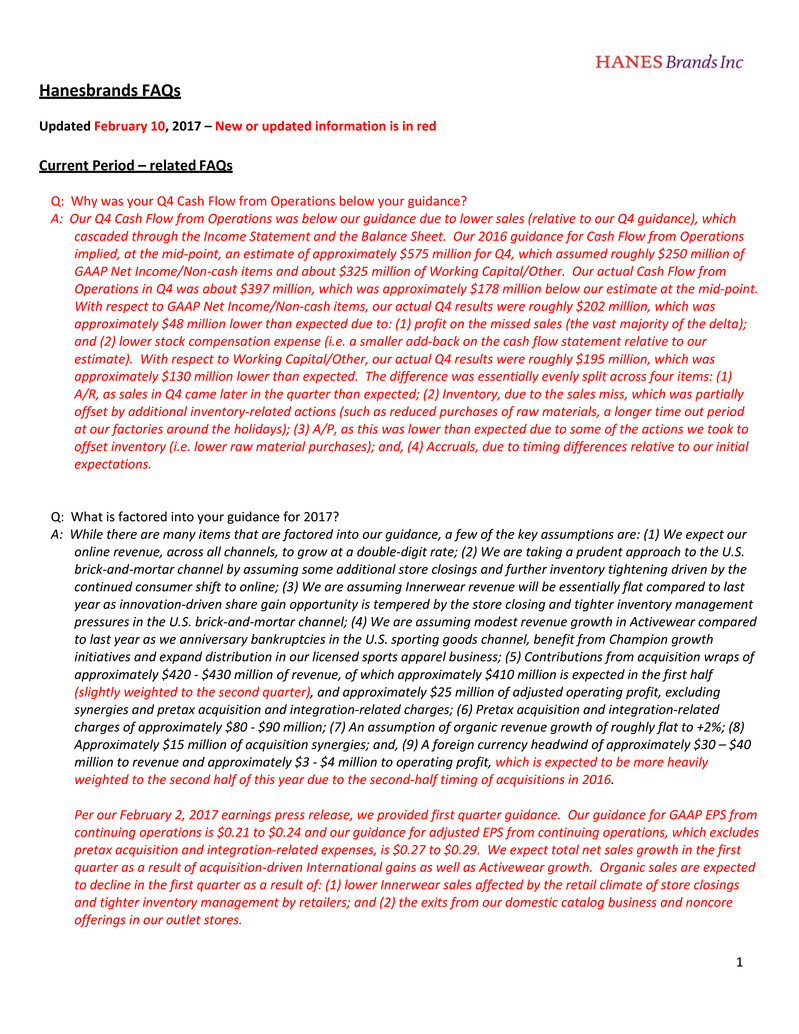
1
Hanesbrands FAQs
Updated February 10, 2017 – New or updated information is in red
Current Period – related FAQs
Q: Why was your Q4 Cash Flow from Operations below your guidance?
A: Our Q4 Cash Flow from Operations was below our guidance due to lower sales (relative to our Q4 guidance), which
cascaded through the Income Statement and the Balance Sheet. Our 2016 guidance for Cash Flow from Operations
implied, at the mid‐point, an estimate of approximately $575 million for Q4, which assumed roughly $250 million of
GAAP Net Income/Non‐cash items and about $325 million of Working Capital/Other. Our actual Cash Flow from
Operations in Q4 was about $397 million, which was approximately $178 million below our estimate at the mid‐point.
With respect to GAAP Net Income/Non‐cash items, our actual Q4 results were roughly $202 million, which was
approximately $48 million lower than expected due to: (1) profit on the missed sales (the vast majority of the delta);
and (2) lower stock compensation expense (i.e. a smaller add‐back on the cash flow statement relative to our
estimate). With respect to Working Capital/Other, our actual Q4 results were roughly $195 million, which was
approximately $130 million lower than expected. The difference was essentially evenly split across four items: (1)
A/R, as sales in Q4 came later in the quarter than expected; (2) Inventory, due to the sales miss, which was partially
offset by additional inventory‐related actions (such as reduced purchases of raw materials, a longer time out period
at our factories around the holidays); (3) A/P, as this was lower than expected due to some of the actions we took to
offset inventory (i.e. lower raw material purchases); and, (4) Accruals, due to timing differences relative to our initial
expectations.
Q: What is factored into your guidance for 2017?
A: While there are many items that are factored into our guidance, a few of the key assumptions are: (1) We expect our
online revenue, across all channels, to grow at a double‐digit rate; (2) We are taking a prudent approach to the U.S.
brick‐and‐mortar channel by assuming some additional store closings and further inventory tightening driven by the
continued consumer shift to online; (3) We are assuming Innerwear revenue will be essentially flat compared to last
year as innovation‐driven share gain opportunity is tempered by the store closing and tighter inventory management
pressures in the U.S. brick‐and‐mortar channel; (4) We are assuming modest revenue growth in Activewear compared
to last year as we anniversary bankruptcies in the U.S. sporting goods channel, benefit from Champion growth
initiatives and expand distribution in our licensed sports apparel business; (5) Contributions from acquisition wraps of
approximately $420 ‐ $430 million of revenue, of which approximately $410 million is expected in the first half
(slightly weighted to the second quarter), and approximately $25 million of adjusted operating profit, excluding
synergies and pretax acquisition and integration‐related charges; (6) Pretax acquisition and integration‐related
charges of approximately $80 ‐ $90 million; (7) An assumption of organic revenue growth of roughly flat to +2%; (8)
Approximately $15 million of acquisition synergies; and, (9) A foreign currency headwind of approximately $30 – $40
million to revenue and approximately $3 ‐ $4 million to operating profit, which is expected to be more heavily
weighted to the second half of this year due to the second‐half timing of acquisitions in 2016.
Per our February 2, 2017 earnings press release, we provided first quarter guidance. Our guidance for GAAP EPS from
continuing operations is $0.21 to $0.24 and our guidance for adjusted EPS from continuing operations, which excludes
pretax acquisition and integration‐related expenses, is $0.27 to $0.29. We expect total net sales growth in the first
quarter as a result of acquisition‐driven International gains as well as Activewear growth. Organic sales are expected
to decline in the first quarter as a result of: (1) lower Innerwear sales affected by the retail climate of store closings
and tighter inventory management by retailers; and (2) the exits from our domestic catalog business and noncore
offerings in our outlet stores.
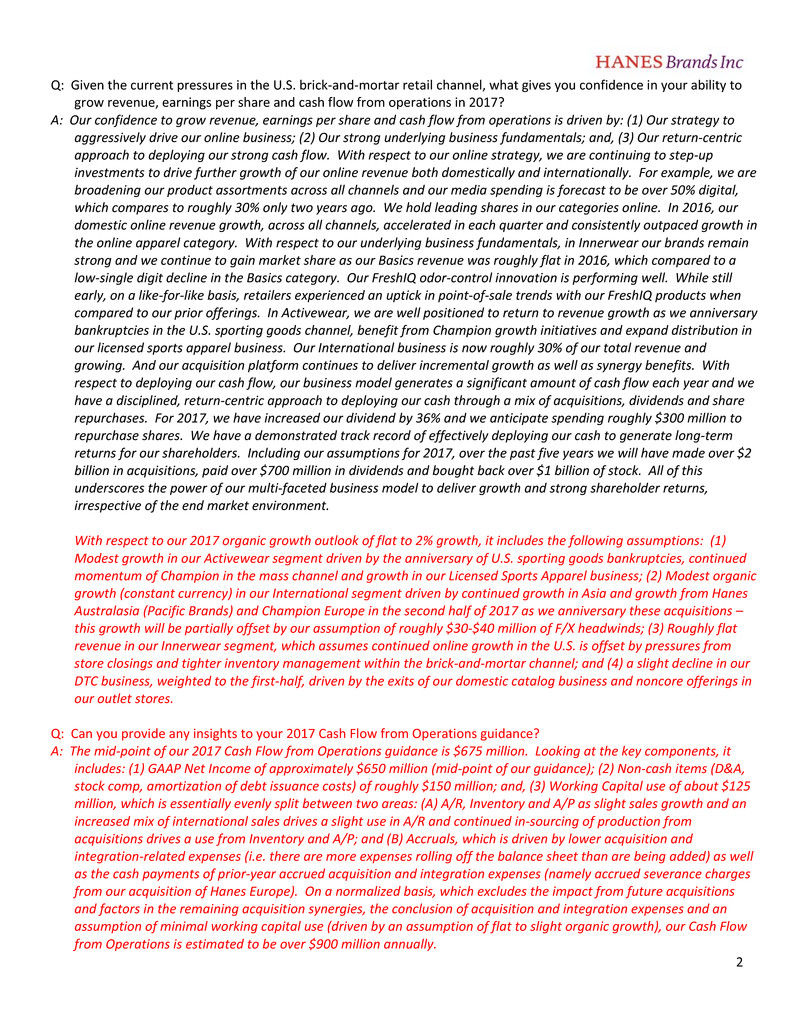
2
Q: Given the current pressures in the U.S. brick‐and‐mortar retail channel, what gives you confidence in your ability to
grow revenue, earnings per share and cash flow from operations in 2017?
A: Our confidence to grow revenue, earnings per share and cash flow from operations is driven by: (1) Our strategy to
aggressively drive our online business; (2) Our strong underlying business fundamentals; and, (3) Our return‐centric
approach to deploying our strong cash flow. With respect to our online strategy, we are continuing to step‐up
investments to drive further growth of our online revenue both domestically and internationally. For example, we are
broadening our product assortments across all channels and our media spending is forecast to be over 50% digital,
which compares to roughly 30% only two years ago. We hold leading shares in our categories online. In 2016, our
domestic online revenue growth, across all channels, accelerated in each quarter and consistently outpaced growth in
the online apparel category. With respect to our underlying business fundamentals, in Innerwear our brands remain
strong and we continue to gain market share as our Basics revenue was roughly flat in 2016, which compared to a
low‐single digit decline in the Basics category. Our FreshIQ odor‐control innovation is performing well. While still
early, on a like‐for‐like basis, retailers experienced an uptick in point‐of‐sale trends with our FreshIQ products when
compared to our prior offerings. In Activewear, we are well positioned to return to revenue growth as we anniversary
bankruptcies in the U.S. sporting goods channel, benefit from Champion growth initiatives and expand distribution in
our licensed sports apparel business. Our International business is now roughly 30% of our total revenue and
growing. And our acquisition platform continues to deliver incremental growth as well as synergy benefits. With
respect to deploying our cash flow, our business model generates a significant amount of cash flow each year and we
have a disciplined, return‐centric approach to deploying our cash through a mix of acquisitions, dividends and share
repurchases. For 2017, we have increased our dividend by 36% and we anticipate spending roughly $300 million to
repurchase shares. We have a demonstrated track record of effectively deploying our cash to generate long‐term
returns for our shareholders. Including our assumptions for 2017, over the past five years we will have made over $2
billion in acquisitions, paid over $700 million in dividends and bought back over $1 billion of stock. All of this
underscores the power of our multi‐faceted business model to deliver growth and strong shareholder returns,
irrespective of the end market environment.
With respect to our 2017 organic growth outlook of flat to 2% growth, it includes the following assumptions: (1)
Modest growth in our Activewear segment driven by the anniversary of U.S. sporting goods bankruptcies, continued
momentum of Champion in the mass channel and growth in our Licensed Sports Apparel business; (2) Modest organic
growth (constant currency) in our International segment driven by continued growth in Asia and growth from Hanes
Australasia (Pacific Brands) and Champion Europe in the second half of 2017 as we anniversary these acquisitions –
this growth will be partially offset by our assumption of roughly $30‐$40 million of F/X headwinds; (3) Roughly flat
revenue in our Innerwear segment, which assumes continued online growth in the U.S. is offset by pressures from
store closings and tighter inventory management within the brick‐and‐mortar channel; and (4) a slight decline in our
DTC business, weighted to the first‐half, driven by the exits of our domestic catalog business and noncore offerings in
our outlet stores.
Q: Can you provide any insights to your 2017 Cash Flow from Operations guidance?
A: The mid‐point of our 2017 Cash Flow from Operations guidance is $675 million. Looking at the key components, it
includes: (1) GAAP Net Income of approximately $650 million (mid‐point of our guidance); (2) Non‐cash items (D&A,
stock comp, amortization of debt issuance costs) of roughly $150 million; and, (3) Working Capital use of about $125
million, which is essentially evenly split between two areas: (A) A/R, Inventory and A/P as slight sales growth and an
increased mix of international sales drives a slight use in A/R and continued in‐sourcing of production from
acquisitions drives a use from Inventory and A/P; and (B) Accruals, which is driven by lower acquisition and
integration‐related expenses (i.e. there are more expenses rolling off the balance sheet than are being added) as well
as the cash payments of prior‐year accrued acquisition and integration expenses (namely accrued severance charges
from our acquisition of Hanes Europe). On a normalized basis, which excludes the impact from future acquisitions
and factors in the remaining acquisition synergies, the conclusion of acquisition and integration expenses and an
assumption of minimal working capital use (driven by an assumption of flat to slight organic growth), our Cash Flow
from Operations is estimated to be over $900 million annually.
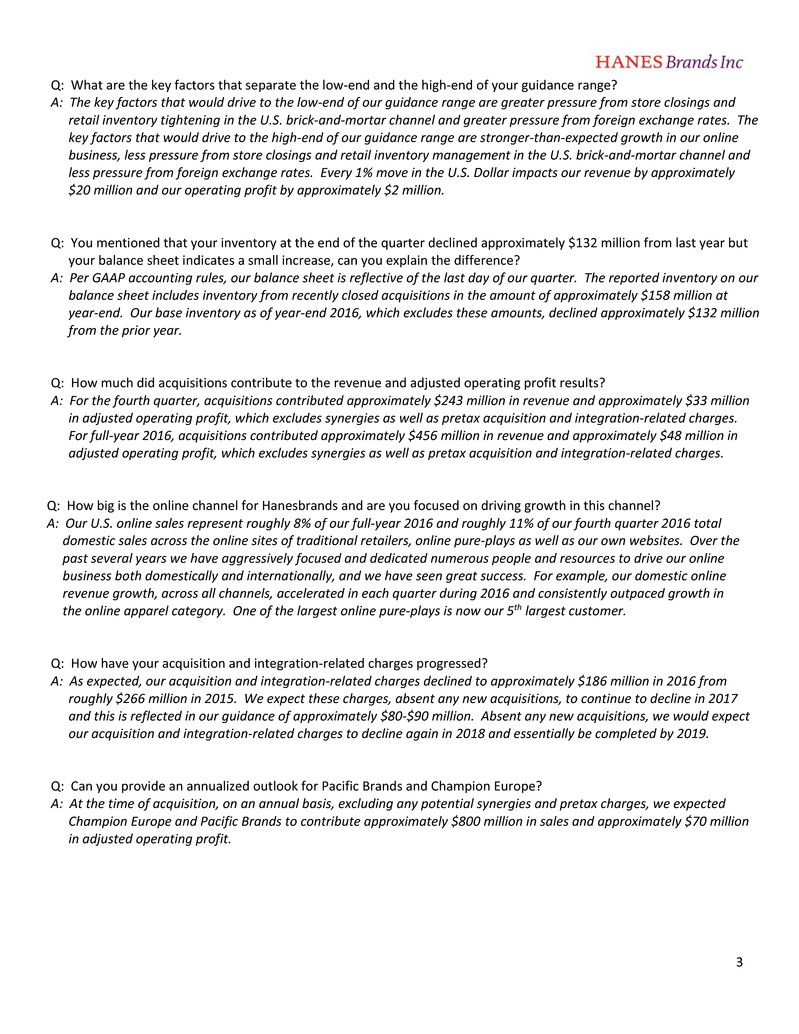
3
Q: What are the key factors that separate the low‐end and the high‐end of your guidance range?
A: The key factors that would drive to the low‐end of our guidance range are greater pressure from store closings and
retail inventory tightening in the U.S. brick‐and‐mortar channel and greater pressure from foreign exchange rates. The
key factors that would drive to the high‐end of our guidance range are stronger‐than‐expected growth in our online
business, less pressure from store closings and retail inventory management in the U.S. brick‐and‐mortar channel and
less pressure from foreign exchange rates. Every 1% move in the U.S. Dollar impacts our revenue by approximately
$20 million and our operating profit by approximately $2 million.
Q: You mentioned that your inventory at the end of the quarter declined approximately $132 million from last year but
your balance sheet indicates a small increase, can you explain the difference?
A: Per GAAP accounting rules, our balance sheet is reflective of the last day of our quarter. The reported inventory on our
balance sheet includes inventory from recently closed acquisitions in the amount of approximately $158 million at
year‐end. Our base inventory as of year‐end 2016, which excludes these amounts, declined approximately $132 million
from the prior year.
Q: How much did acquisitions contribute to the revenue and adjusted operating profit results?
A: For the fourth quarter, acquisitions contributed approximately $243 million in revenue and approximately $33 million
in adjusted operating profit, which excludes synergies as well as pretax acquisition and integration‐related charges.
For full‐year 2016, acquisitions contributed approximately $456 million in revenue and approximately $48 million in
adjusted operating profit, which excludes synergies as well as pretax acquisition and integration‐related charges.
Q: How big is the online channel for Hanesbrands and are you focused on driving growth in this channel?
A: Our U.S. online sales represent roughly 8% of our full‐year 2016 and roughly 11% of our fourth quarter 2016 total
domestic sales across the online sites of traditional retailers, online pure‐plays as well as our own websites. Over the
past several years we have aggressively focused and dedicated numerous people and resources to drive our online
business both domestically and internationally, and we have seen great success. For example, our domestic online
revenue growth, across all channels, accelerated in each quarter during 2016 and consistently outpaced growth in
the online apparel category. One of the largest online pure‐plays is now our 5th largest customer.
Q: How have your acquisition and integration‐related charges progressed?
A: As expected, our acquisition and integration‐related charges declined to approximately $186 million in 2016 from
roughly $266 million in 2015. We expect these charges, absent any new acquisitions, to continue to decline in 2017
and this is reflected in our guidance of approximately $80‐$90 million. Absent any new acquisitions, we would expect
our acquisition and integration‐related charges to decline again in 2018 and essentially be completed by 2019.
Q: Can you provide an annualized outlook for Pacific Brands and Champion Europe?
A: At the time of acquisition, on an annual basis, excluding any potential synergies and pretax charges, we expected
Champion Europe and Pacific Brands to contribute approximately $800 million in sales and approximately $70 million
in adjusted operating profit.
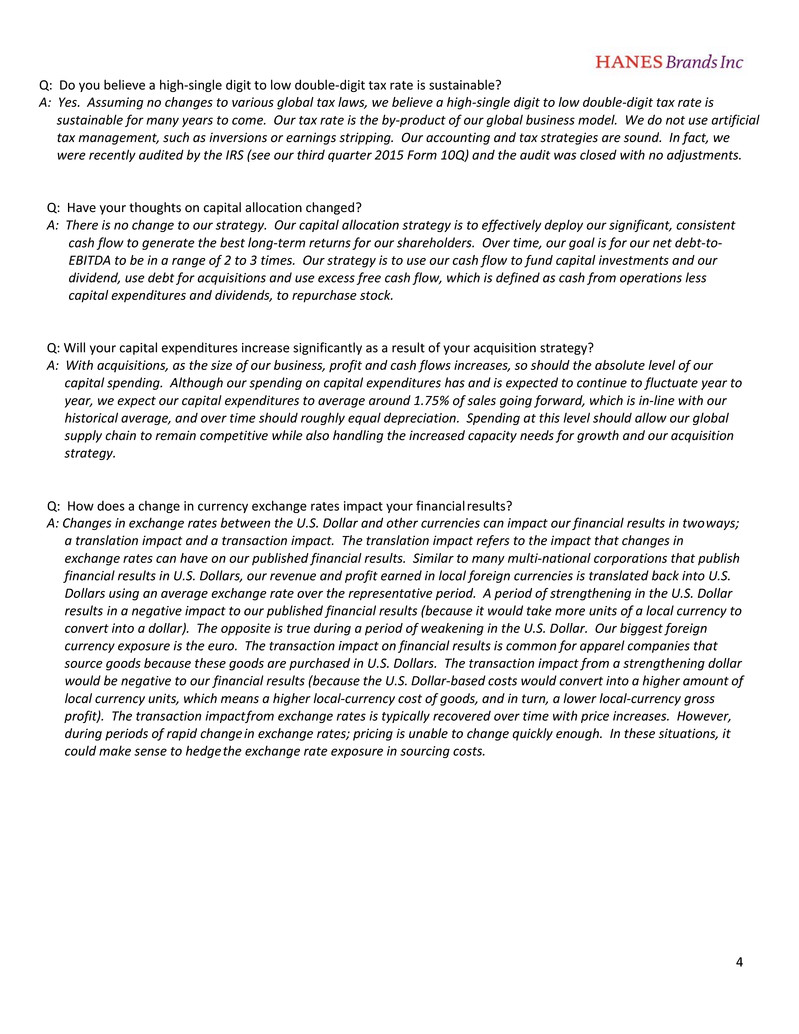
4
Q: Do you believe a high‐single digit to low double‐digit tax rate is sustainable?
A: Yes. Assuming no changes to various global tax laws, we believe a high‐single digit to low double‐digit tax rate is
sustainable for many years to come. Our tax rate is the by‐product of our global business model. We do not use artificial
tax management, such as inversions or earnings stripping. Our accounting and tax strategies are sound. In fact, we
were recently audited by the IRS (see our third quarter 2015 Form 10Q) and the audit was closed with no adjustments.
Q: Have your thoughts on capital allocation changed?
A: There is no change to our strategy. Our capital allocation strategy is to effectively deploy our significant, consistent
cash flow to generate the best long‐term returns for our shareholders. Over time, our goal is for our net debt‐to‐
EBITDA to be in a range of 2 to 3 times. Our strategy is to use our cash flow to fund capital investments and our
dividend, use debt for acquisitions and use excess free cash flow, which is defined as cash from operations less
capital expenditures and dividends, to repurchase stock.
Q: Will your capital expenditures increase significantly as a result of your acquisition strategy?
A: With acquisitions, as the size of our business, profit and cash flows increases, so should the absolute level of our
capital spending. Although our spending on capital expenditures has and is expected to continue to fluctuate year to
year, we expect our capital expenditures to average around 1.75% of sales going forward, which is in‐line with our
historical average, and over time should roughly equal depreciation. Spending at this level should allow our global
supply chain to remain competitive while also handling the increased capacity needs for growth and our acquisition
strategy.
Q: How does a change in currency exchange rates impact your financial results?
A: Changes in exchange rates between the U.S. Dollar and other currencies can impact our financial results in two ways;
a translation impact and a transaction impact. The translation impact refers to the impact that changes in
exchange rates can have on our published financial results. Similar to many multi‐national corporations that publish
financial results in U.S. Dollars, our revenue and profit earned in local foreign currencies is translated back into U.S.
Dollars using an average exchange rate over the representative period. A period of strengthening in the U.S. Dollar
results in a negative impact to our published financial results (because it would take more units of a local currency to
convert into a dollar). The opposite is true during a period of weakening in the U.S. Dollar. Our biggest foreign
currency exposure is the euro. The transaction impact on financial results is common for apparel companies that
source goods because these goods are purchased in U.S. Dollars. The transaction impact from a strengthening dollar
would be negative to our financial results (because the U.S. Dollar‐based costs would convert into a higher amount of
local currency units, which means a higher local‐currency cost of goods, and in turn, a lower local‐currency gross
profit). The transaction impact from exchange rates is typically recovered over time with price increases. However,
during periods of rapid change in exchange rates; pricing is unable to change quickly enough. In these situations, it
could make sense to hedge the exchange rate exposure in sourcing costs.
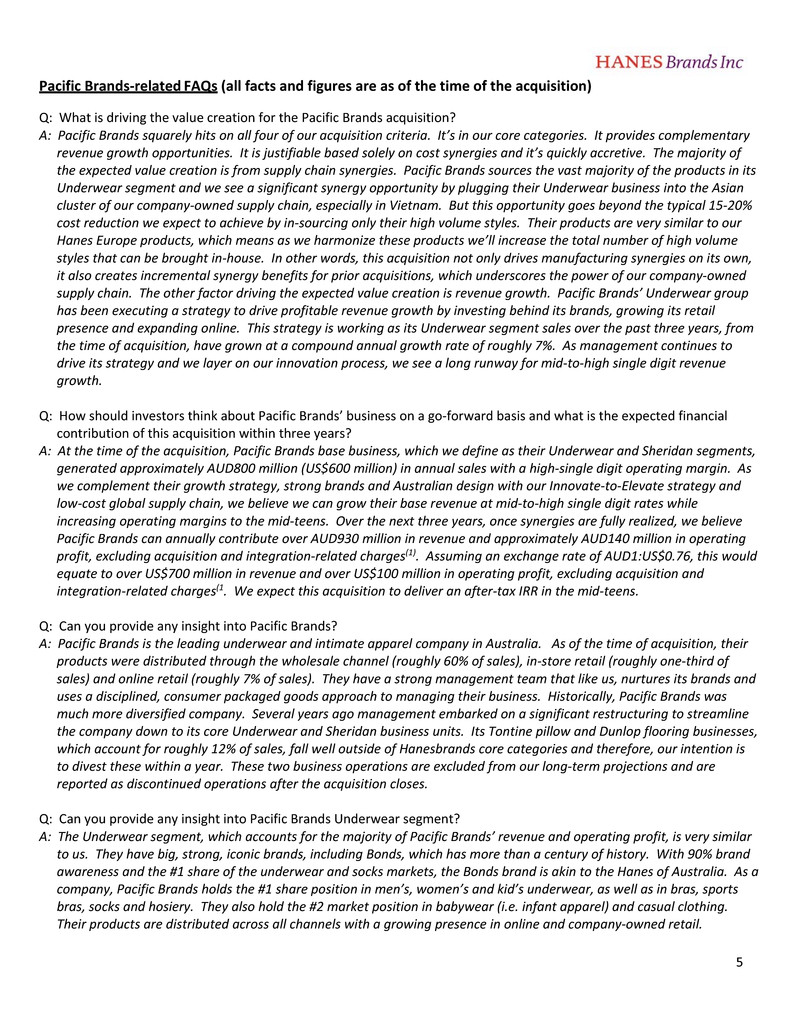
5
Pacific Brands‐related FAQs (all facts and figures are as of the time of the acquisition)
Q: What is driving the value creation for the Pacific Brands acquisition?
A: Pacific Brands squarely hits on all four of our acquisition criteria. It’s in our core categories. It provides complementary
revenue growth opportunities. It is justifiable based solely on cost synergies and it’s quickly accretive. The majority of
the expected value creation is from supply chain synergies. Pacific Brands sources the vast majority of the products in its
Underwear segment and we see a significant synergy opportunity by plugging their Underwear business into the Asian
cluster of our company‐owned supply chain, especially in Vietnam. But this opportunity goes beyond the typical 15‐20%
cost reduction we expect to achieve by in‐sourcing only their high volume styles. Their products are very similar to our
Hanes Europe products, which means as we harmonize these products we’ll increase the total number of high volume
styles that can be brought in‐house. In other words, this acquisition not only drives manufacturing synergies on its own,
it also creates incremental synergy benefits for prior acquisitions, which underscores the power of our company‐owned
supply chain. The other factor driving the expected value creation is revenue growth. Pacific Brands’ Underwear group
has been executing a strategy to drive profitable revenue growth by investing behind its brands, growing its retail
presence and expanding online. This strategy is working as its Underwear segment sales over the past three years, from
the time of acquisition, have grown at a compound annual growth rate of roughly 7%. As management continues to
drive its strategy and we layer on our innovation process, we see a long runway for mid‐to‐high single digit revenue
growth.
Q: How should investors think about Pacific Brands’ business on a go‐forward basis and what is the expected financial
contribution of this acquisition within three years?
A: At the time of the acquisition, Pacific Brands base business, which we define as their Underwear and Sheridan segments,
generated approximately AUD800 million (US$600 million) in annual sales with a high‐single digit operating margin. As
we complement their growth strategy, strong brands and Australian design with our Innovate‐to‐Elevate strategy and
low‐cost global supply chain, we believe we can grow their base revenue at mid‐to‐high single digit rates while
increasing operating margins to the mid‐teens. Over the next three years, once synergies are fully realized, we believe
Pacific Brands can annually contribute over AUD930 million in revenue and approximately AUD140 million in operating
profit, excluding acquisition and integration‐related charges(1). Assuming an exchange rate of AUD1:US$0.76, this would
equate to over US$700 million in revenue and over US$100 million in operating profit, excluding acquisition and
integration‐related charges(1. We expect this acquisition to deliver an after‐tax IRR in the mid‐teens.
Q: Can you provide any insight into Pacific Brands?
A: Pacific Brands is the leading underwear and intimate apparel company in Australia. As of the time of acquisition, their
products were distributed through the wholesale channel (roughly 60% of sales), in‐store retail (roughly one‐third of
sales) and online retail (roughly 7% of sales). They have a strong management team that like us, nurtures its brands and
uses a disciplined, consumer packaged goods approach to managing their business. Historically, Pacific Brands was
much more diversified company. Several years ago management embarked on a significant restructuring to streamline
the company down to its core Underwear and Sheridan business units. Its Tontine pillow and Dunlop flooring businesses,
which account for roughly 12% of sales, fall well outside of Hanesbrands core categories and therefore, our intention is
to divest these within a year. These two business operations are excluded from our long‐term projections and are
reported as discontinued operations after the acquisition closes.
Q: Can you provide any insight into Pacific Brands Underwear segment?
A: The Underwear segment, which accounts for the majority of Pacific Brands’ revenue and operating profit, is very similar
to us. They have big, strong, iconic brands, including Bonds, which has more than a century of history. With 90% brand
awareness and the #1 share of the underwear and socks markets, the Bonds brand is akin to the Hanes of Australia. As a
company, Pacific Brands holds the #1 share position in men’s, women’s and kid’s underwear, as well as in bras, sports
bras, socks and hosiery. They also hold the #2 market position in babywear (i.e. infant apparel) and casual clothing.
Their products are distributed across all channels with a growing presence in online and company‐owned retail.
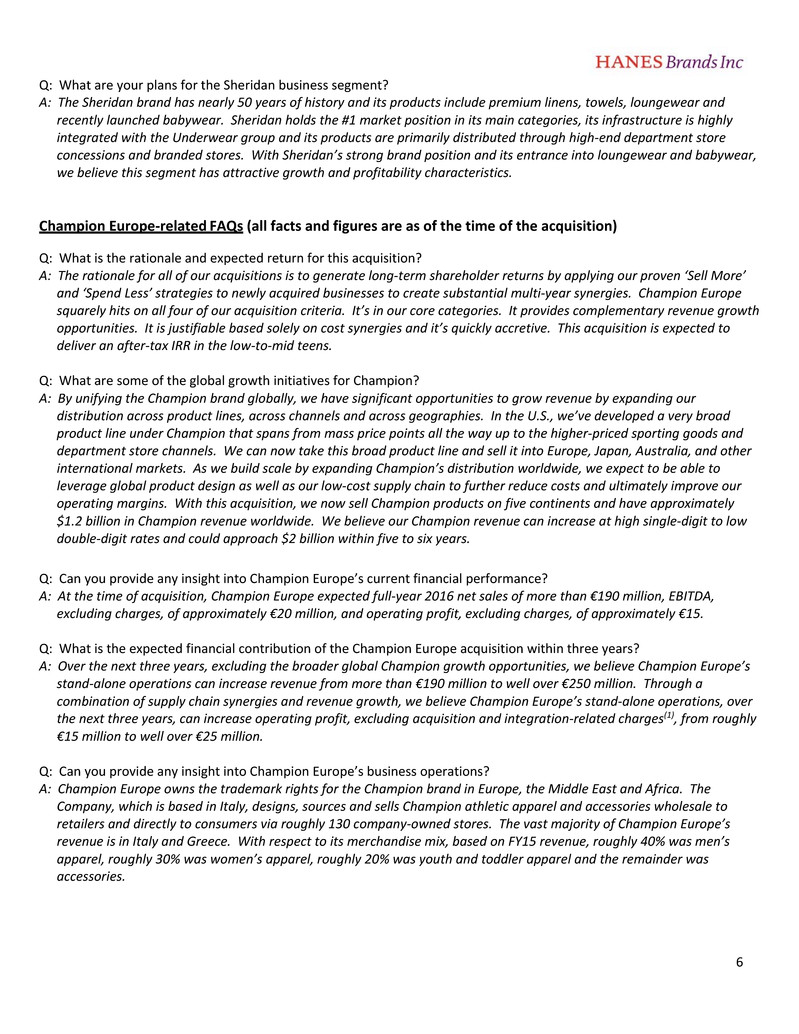
6
Q: What are your plans for the Sheridan business segment?
A: The Sheridan brand has nearly 50 years of history and its products include premium linens, towels, loungewear and
recently launched babywear. Sheridan holds the #1 market position in its main categories, its infrastructure is highly
integrated with the Underwear group and its products are primarily distributed through high‐end department store
concessions and branded stores. With Sheridan’s strong brand position and its entrance into loungewear and babywear,
we believe this segment has attractive growth and profitability characteristics.
Champion Europe‐related FAQs (all facts and figures are as of the time of the acquisition)
Q: What is the rationale and expected return for this acquisition?
A: The rationale for all of our acquisitions is to generate long‐term shareholder returns by applying our proven ‘Sell More’
and ‘Spend Less’ strategies to newly acquired businesses to create substantial multi‐year synergies. Champion Europe
squarely hits on all four of our acquisition criteria. It’s in our core categories. It provides complementary revenue growth
opportunities. It is justifiable based solely on cost synergies and it’s quickly accretive. This acquisition is expected to
deliver an after‐tax IRR in the low‐to‐mid teens.
Q: What are some of the global growth initiatives for Champion?
A: By unifying the Champion brand globally, we have significant opportunities to grow revenue by expanding our
distribution across product lines, across channels and across geographies. In the U.S., we’ve developed a very broad
product line under Champion that spans from mass price points all the way up to the higher‐priced sporting goods and
department store channels. We can now take this broad product line and sell it into Europe, Japan, Australia, and other
international markets. As we build scale by expanding Champion’s distribution worldwide, we expect to be able to
leverage global product design as well as our low‐cost supply chain to further reduce costs and ultimately improve our
operating margins. With this acquisition, we now sell Champion products on five continents and have approximately
$1.2 billion in Champion revenue worldwide. We believe our Champion revenue can increase at high single‐digit to low
double‐digit rates and could approach $2 billion within five to six years.
Q: Can you provide any insight into Champion Europe’s current financial performance?
A: At the time of acquisition, Champion Europe expected full‐year 2016 net sales of more than €190 million, EBITDA,
excluding charges, of approximately €20 million, and operating profit, excluding charges, of approximately €15.
Q: What is the expected financial contribution of the Champion Europe acquisition within three years?
A: Over the next three years, excluding the broader global Champion growth opportunities, we believe Champion Europe’s
stand‐alone operations can increase revenue from more than €190 million to well over €250 million. Through a
combination of supply chain synergies and revenue growth, we believe Champion Europe’s stand‐alone operations, over
the next three years, can increase operating profit, excluding acquisition and integration‐related charges(1), from roughly
€15 million to well over €25 million.
Q: Can you provide any insight into Champion Europe’s business operations?
A: Champion Europe owns the trademark rights for the Champion brand in Europe, the Middle East and Africa. The
Company, which is based in Italy, designs, sources and sells Champion athletic apparel and accessories wholesale to
retailers and directly to consumers via roughly 130 company‐owned stores. The vast majority of Champion Europe’s
revenue is in Italy and Greece. With respect to its merchandise mix, based on FY15 revenue, roughly 40% was men’s
apparel, roughly 30% was women’s apparel, roughly 20% was youth and toddler apparel and the remainder was
accessories.

7
Q: Will Champion Europe be integrated into Hanes Europe Innerwear?
A: No. We run Innerwear and Activewear separately in the U.S. and we will do the same in Europe. There are no real
synergies to be gained by integrating these two businesses. Champion Europe will be integrated into our global supply
chain but it will be run as part of the global Champion Activewear business.
(1) We currently estimate the total, combined acquisition and integration costs for Champion Europe and Pacific Brands to
be less than $100 million.
# # #
Charges for Actions and Reconciliation to GAAP Measures
To supplement our financial guidance prepared in accordance with generally accepted accounting principles, we provide
quarterly and full‐year results and guidance concerning certain non‐GAAP financial measures, including adjusted EPS,
adjusted net income, adjusted operating profit (and margin), adjusted SG&A, adjusted gross profit (and margin) and
EBITDA.
Adjusted EPS is defined as diluted EPS excluding actions and the tax effect on actions. Adjusted net income is defined as net
income excluding actions and the tax effect on actions. Adjusted operating profit is defined as operating profit excluding
actions. Adjusted gross profit is defined as gross profit excluding actions. Adjusted SG&A is defined as selling, general and
administrative expenses excluding actions. EBITDA is defined as earnings before interest, taxes, depreciation and
amortization.
Actions during the periods presented include adjustments for acquisition and integration costs, foundational costs and
other costs. Acquisition and integration costs include adjustments directly related to completed acquisitions and their
integration. These costs include legal fees, consulting fees, bank fees, severance costs, certain purchase accounting items,
facility closures, inventory write‐offs, information technology integration costs, and similar charges. These costs also
include adjustments for acquisition‐related currency transactions during the period to remove the effect of foreign
exchange gains from financing activities related to these acquisitions. Foundational costs are expenses associated with
building and realigning enterprise‐wide infrastructure to support global growth and future acquisitions, primarily consisting
of information technology spending. All foundational costs were completed in 2015. Other costs relate to other items not
included in the aforementioned categories, primarily consisting of noncash items related to the exit of the commercial
sales organization in the China market in 2015. While these costs are not operational in nature and are not expected to
continue for any singular transaction on an ongoing basis, similar types of costs, expenses and charges have occurred in
prior periods and may recur in the future as the company continues to integrate prior acquisitions and pursues any future
acquisitions. We have chosen to present non‐GAAP measures excluding the effects of these actions to investors to enable
additional analyses of past, present and future operating performance and as a supplemental means of evaluating
operations absent the effect of acquisition‐related expenses and other actions. We believe these non‐GAAP measures
provide management and investors with valuable supplemental information for analyzing the operating performance of
the company’s ongoing business during each period presented without giving effect to costs or foreign currency gains
associated with the execution and integration of any of the aforementioned actions taken.
In addition to these non‐GAAP measures, we have chosen to present EBITDA to investors because we consider it to be an
important supplemental means of evaluating operating performance. We believe that EBITDA is frequently used by
securities analysts, investors and other interested parties in the evaluation of companies in the industry, and management
uses EBITDA for planning purposes in connection with setting its capital allocation strategy. EBITDA should not, however,
be considered as a measure of discretionary cash available to invest in the growth of the business.
Non‐GAAP financial measures have limitations as analytical tools and should not be considered in isolation or as an
alternative to, or substitute for, financial results prepared in accordance with GAAP. Further, the non‐GAAP measures
presented may be different from non‐GAAP measures with similar or identical names presented by other companies.
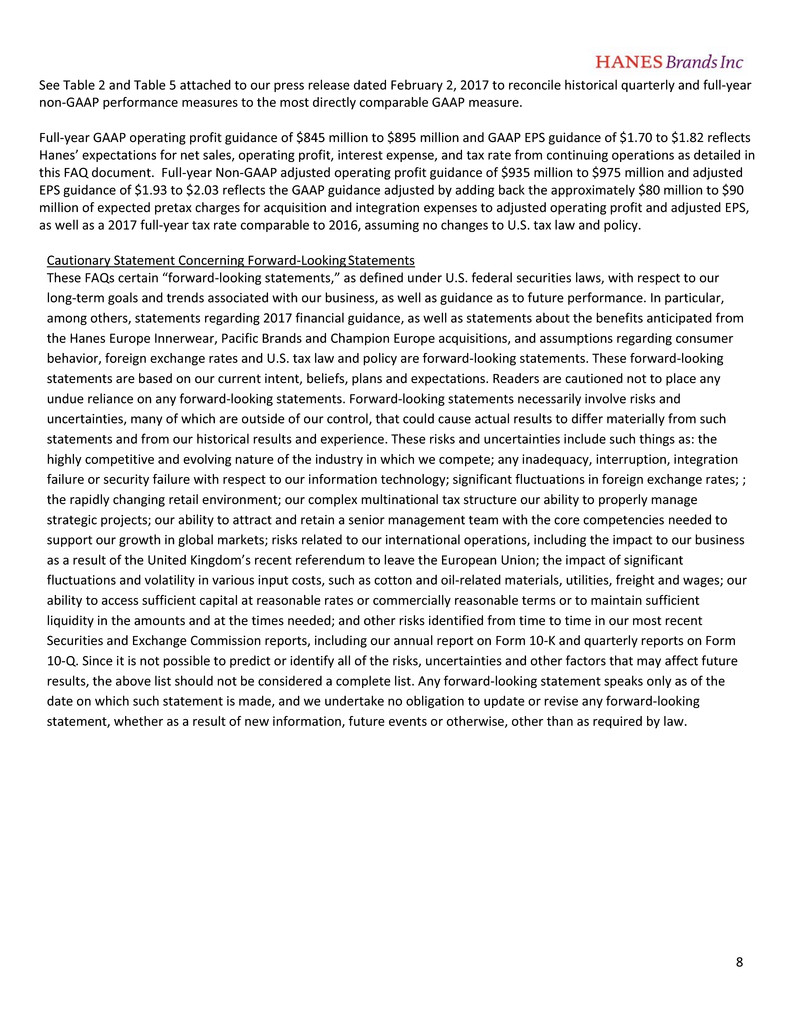
8
See Table 2 and Table 5 attached to our press release dated February 2, 2017 to reconcile historical quarterly and full‐year
non‐GAAP performance measures to the most directly comparable GAAP measure.
Full‐year GAAP operating profit guidance of $845 million to $895 million and GAAP EPS guidance of $1.70 to $1.82 reflects
Hanes’ expectations for net sales, operating profit, interest expense, and tax rate from continuing operations as detailed in
this FAQ document. Full‐year Non‐GAAP adjusted operating profit guidance of $935 million to $975 million and adjusted
EPS guidance of $1.93 to $2.03 reflects the GAAP guidance adjusted by adding back the approximately $80 million to $90
million of expected pretax charges for acquisition and integration expenses to adjusted operating profit and adjusted EPS,
as well as a 2017 full‐year tax rate comparable to 2016, assuming no changes to U.S. tax law and policy.
Cautionary Statement Concerning Forward‐Looking Statements
These FAQs certain “forward‐looking statements,” as defined under U.S. federal securities laws, with respect to our
long‐term goals and trends associated with our business, as well as guidance as to future performance. In particular,
among others, statements regarding 2017 financial guidance, as well as statements about the benefits anticipated from
the Hanes Europe Innerwear, Pacific Brands and Champion Europe acquisitions, and assumptions regarding consumer
behavior, foreign exchange rates and U.S. tax law and policy are forward‐looking statements. These forward‐looking
statements are based on our current intent, beliefs, plans and expectations. Readers are cautioned not to place any
undue reliance on any forward‐looking statements. Forward‐looking statements necessarily involve risks and
uncertainties, many of which are outside of our control, that could cause actual results to differ materially from such
statements and from our historical results and experience. These risks and uncertainties include such things as: the
highly competitive and evolving nature of the industry in which we compete; any inadequacy, interruption, integration
failure or security failure with respect to our information technology; significant fluctuations in foreign exchange rates; ;
the rapidly changing retail environment; our complex multinational tax structure our ability to properly manage
strategic projects; our ability to attract and retain a senior management team with the core competencies needed to
support our growth in global markets; risks related to our international operations, including the impact to our business
as a result of the United Kingdom’s recent referendum to leave the European Union; the impact of significant
fluctuations and volatility in various input costs, such as cotton and oil‐related materials, utilities, freight and wages; our
ability to access sufficient capital at reasonable rates or commercially reasonable terms or to maintain sufficient
liquidity in the amounts and at the times needed; and other risks identified from time to time in our most recent
Securities and Exchange Commission reports, including our annual report on Form 10‐K and quarterly reports on Form
10‐Q. Since it is not possible to predict or identify all of the risks, uncertainties and other factors that may affect future
results, the above list should not be considered a complete list. Any forward‐looking statement speaks only as of the
date on which such statement is made, and we undertake no obligation to update or revise any forward‐looking
statement, whether as a result of new information, future events or otherwise, other than as required by law.
